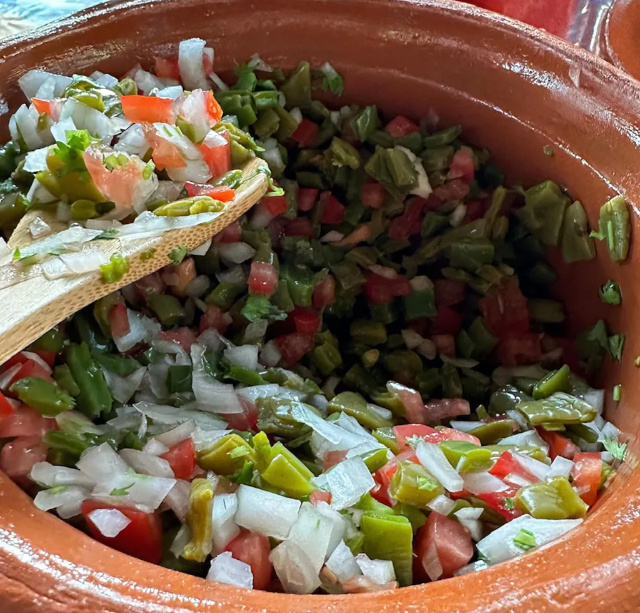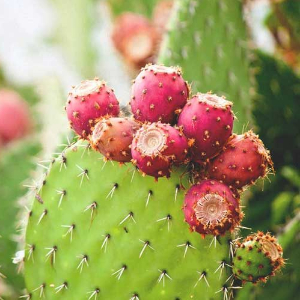Today, I have a surprise for you. Well, more than one, really. But they all add up to one big thing: Pretty much wherever you are in North America, you can enjoy the unique dining experience offered by the Prickly Pear Cactus!
 Prickly Pear Salad: Looks a little like Pico de Gallo – but no peppers or lime juice.
Prickly Pear Salad: Looks a little like Pico de Gallo – but no peppers or lime juice.
Definitely an ensalada, not a salsa. Just one of many Prickly Pear dishes.
I was cruising recent BBC food articles when I came across a recipe – a tradition, really – that intrigued me. But I would have passed it over as a topic for a post if I hadn’t discovered another intriguing fact.
A prickly proposition
The recipe came by way of a ‘World’s Table’ feature in which the author learned how to prepare the ubiquitous succulent. Journalist Nicole Melancon got the authentic info on harvesting and preparing the Prickly Pear from a grower in Baja.
The plant, known in Spanish as the Nopal, grows everywhere in Mexico and the southwestern U.S. It reproduces at the drop of a hat and thrives in harsh climates. No wonder it’s a staple in Mexico.
What I wonder about is, why haven’t folks in the rest of the U.S. and Canada put it kin their menus?
Harsh climates?
Greenventure Canada insists the Prickly Pear can thrive without any human help as far north as Southern Ontario. There’s a permanent ‘colony’ at the Long Point nature reserve on the north shore of Lake Erie.
“When you think of Canadian plants, a cactus is probably not the first thing that comes to mind. Many people may be surprised to learn that Canada even has any native cacti given how far north we are, but we do! The species of Prickly Pear, known as the Eastern Prickly Pear (aka Devil’s Tongue or Indian Fig), has a range that extends from down in New Mexico, up to Montana, and over to the southern part of the Great Lakes. It is a low growing cactus that grows flat, teardrop shaped pads and produces a reddish-brown fruit in the right conditions.”
Folks with a mind to, across southern Canada can plant the Prickly Pear in their gardens. But that shouldn’t surprise experienced gardeners, who will already know you can grow Agave in the same areas.
Ancient and venerable pedigree
“The nopal cactus comes from a Nahuatl word ‘nohpalli’ dating back to pre-Columbian times,” said Melancon’s tour guide, Danny Perez. “This cactus is deeply woven into our culture and national identity. It can be found on our flag, in art, and even within ancient mythology based on the founding of Tenochtitlán, the ancient Aztec capital, and modern-day Mexico City. It is very symbolic for the Mexican people.”
Mexican cooks use both the fruits and the spine-festooned pads of the cactus in various ways. “You can do everything with this cactus,” said Rita Garcia, Melancon’s ‘tutor’. “You can boil it, grill it, eat it raw as a juice or add it to a stew, salsas or eggs.”
A popular preparation
But the most popular preparation may be a Nopales Salad. You simply cook the de-spined Nopal pads for 10 minutes or so, until soft. Then dice and mix with diced onion, tomato and garlic.
This salad, in turn, constitutes the base for the popular Nopales Taco, which shares a fresh corn tortilla with soft goat cheese. Another popular application is as a breakfast side, with eggs. Just like we might use fried tomatoes. But, as Rita Garcia says, you could just as easily toss it on the grill or dice it up into a stew.
Melancon suggests it tastes like a ‘slightly tangy’ green bean.
Growing Prickly Pears at home
It’s a versatile addition to any garden, green house, or window box.
Greenventure says: “Eastern Prickly Pears are an excellent addition to a garden if you have a place for them. If not in your garden, they also grow well in containers if you use a sandy cacti mix and fertilize them when appropriate. You can either grow them from seed in the spring or by gentle breaking off a pad and rooting it in a pot of cacti soil. To encourage the growth of more pads, you can fertilize them with a 10-10-10 mix. To encourage more flowers and fruit, you can apply a 0-10-10 mix. It is important that you do not fertilize your cacti in the winter.”
My take
Happy in harsh conditions. Needs little rain. Reproduces easily. High in Vitamin C, Magnesium and fibre. Low in Cholesterol, Salt and Saturated Fats. Both pads and fruits can be eaten. Grows almost anywhere – no need to import over long, expensive distances.
Could the Prickly Pear be the answer (or part of an answer) to the current blight of food insecurity plaguing the world?
~ Maggie J.

